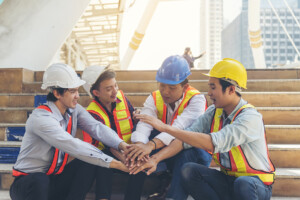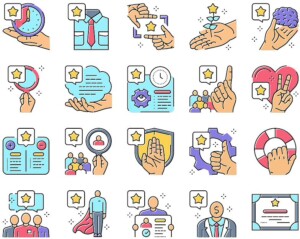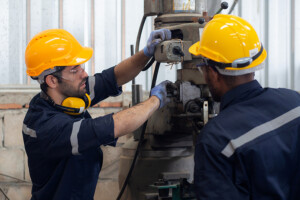 Overburden (muri) is one of the three evils of manufacturing, along with unevenness (mura) and waste (muda). Out of the three, overburden is probably the least understood. Hence, in this post I will look deeper at overburden, including plenty of examples as well as the effects of overburden on your people.
Overburden (muri) is one of the three evils of manufacturing, along with unevenness (mura) and waste (muda). Out of the three, overburden is probably the least understood. Hence, in this post I will look deeper at overburden, including plenty of examples as well as the effects of overburden on your people.
People
Stories and details on the many people contribution to lean manufacturing and modern manufacturing in general.
The Soft Power of the Toyota Production System—Yokoten, Nemawashi, and More
 When we are talking about lean manufacturing, we often focus on the tools like kanban, 5S, SMED, and many more. Sometimes, but harder to grasp, is the underlying culture and philosophy of continuous improvement and PDCA. Part of this culture is what you could call the soft power of the Toyota Production System. This is a form of decision making in contrast with the “hard power” more common in Western companies. Let’s have a look:
When we are talking about lean manufacturing, we often focus on the tools like kanban, 5S, SMED, and many more. Sometimes, but harder to grasp, is the underlying culture and philosophy of continuous improvement and PDCA. Part of this culture is what you could call the soft power of the Toyota Production System. This is a form of decision making in contrast with the “hard power” more common in Western companies. Let’s have a look:
Making the Problem go Away Is NOT Improvement
Managing problems  is an important part of manufacturing because it allows companies to identify and address issues that can impact product quality, production efficiency, and overall profitability. However, it is not to be confused with actual improvement. While taking care of the problem (hopefully) makes the problem go away, actual kaizen requires that the problem should not come back.
is an important part of manufacturing because it allows companies to identify and address issues that can impact product quality, production efficiency, and overall profitability. However, it is not to be confused with actual improvement. While taking care of the problem (hopefully) makes the problem go away, actual kaizen requires that the problem should not come back.
On the Team Structure at Toyota
 Toyota is (among other things) famous for its team structure on the front line. They have a quite low ratio of team members to supervisors, and I believe that is part of their success. Whereas many Western companies overstuff their hierarchy, at Toyota supervisors actually have the time to help their people and to also improve the operations. Let me dig deeper into that. This blog post was inspired by the new book by Baudin and Netland, Introduction to Manufacturing.
Toyota is (among other things) famous for its team structure on the front line. They have a quite low ratio of team members to supervisors, and I believe that is part of their success. Whereas many Western companies overstuff their hierarchy, at Toyota supervisors actually have the time to help their people and to also improve the operations. Let me dig deeper into that. This blog post was inspired by the new book by Baudin and Netland, Introduction to Manufacturing.
Adding Another Axis to the Qualification Matrix—Products
 In my last two posts I talked about the qualification matrix, where you match the skills of your people to the skills needed for your business. This can be expanded with another axis, as for example the skills needed for certain products. This connects your people to your products through skills. It is also more useful for products where a single person assembles an entire product.
In my last two posts I talked about the qualification matrix, where you match the skills of your people to the skills needed for your business. This can be expanded with another axis, as for example the skills needed for certain products. This connects your people to your products through skills. It is also more useful for products where a single person assembles an entire product.
How to Use a Qualification Matrix
 In my last post, I described how to build a qualification matrix (also skill matrix, competence matrix, or Q-Matrix). In this post I will go into more detail on how to use a qualification matrix. By itself, the qualification matrix is a pretty simple but useful tool. This post will help you to get the most out of it.
In my last post, I described how to build a qualification matrix (also skill matrix, competence matrix, or Q-Matrix). In this post I will go into more detail on how to use a qualification matrix. By itself, the qualification matrix is a pretty simple but useful tool. This post will help you to get the most out of it.
How to Establish a Qualification Matrix
 The qualification matrix (also skill matrix, competence matrix, or Q-matrix, one of the few examples where Q does not stand for Quality) is a simple tool to keep track of the qualifications of your employees. It keeps track of who can do what and how well. As a tool, it is not overly complicated but rather simple. Yet, there are still some things to consider for a qualification matrix. Let’s have a look at this basic but very useful tool.
The qualification matrix (also skill matrix, competence matrix, or Q-matrix, one of the few examples where Q does not stand for Quality) is a simple tool to keep track of the qualifications of your employees. It keeps track of who can do what and how well. As a tool, it is not overly complicated but rather simple. Yet, there are still some things to consider for a qualification matrix. Let’s have a look at this basic but very useful tool.
Akio Toyoda Steps Down as Toyota CEO
 Somewhat surprising to industry insiders, the CEO of Toyota Motor, Akio Toyoda, announced on January 26 his resignation, and he will step down as CEO on April 1, 2023, to become the chairman of the board. Hence, I will have a look at his impact on Toyota. However, just to be warned, if you expect glowing praise, you should look elsewhere. I believe he changed Toyota, a company I love, in a worrisome way. I am definitely not a fan of his work. Granted, being a CEO is not easy, and he did have to lead Toyota through a couple of crises (Recall,s Corona, etc.). Compared to other CEO’s, he is probably somewhere around average. But I believe he had a negative influence on the Toyota corporate culture.
Somewhat surprising to industry insiders, the CEO of Toyota Motor, Akio Toyoda, announced on January 26 his resignation, and he will step down as CEO on April 1, 2023, to become the chairman of the board. Hence, I will have a look at his impact on Toyota. However, just to be warned, if you expect glowing praise, you should look elsewhere. I believe he changed Toyota, a company I love, in a worrisome way. I am definitely not a fan of his work. Granted, being a CEO is not easy, and he did have to lead Toyota through a couple of crises (Recall,s Corona, etc.). Compared to other CEO’s, he is probably somewhere around average. But I believe he had a negative influence on the Toyota corporate culture.
